1. Identify the correct statements of the followings.
a) Two degrees of freedom are available at each joint of pin jointed plane frame
b) Six degrees of freedom are available at each joint of pin jointed space frame
c) Four degrees of freedom are available at each joint of rigid jointed plane frame
d) Three degrees of freedom are available at each joint of pin jointed space frame
Explanation: Each joint of pin jointed plane frame, allows horizontal and vertical sway of the joint. Therefore, degree of freedom is two at a joint of pin jointed plane frame.
2. Calculate the kinematic indeterminacy of the following pin jointed plane frame.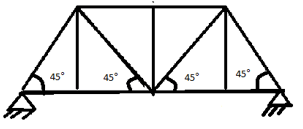
a) 2
b) 6
c) 12
d) 18
Explanation: The truss is supported by hinged support at both ends. Hinged support in a pin jointed plane frame does not offers any degree of freedom as rotation is not considered. For the given truss, it consists of six pin joint offering two degree of freedom each. Therefore, the degree of freedom is 12.
3. Calculate the kinematic indeterminacy of the following pin jointed plane frame.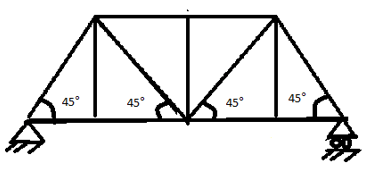
a) 12
b) 13
c) 14
d) 15
Explanation: The truss is supported by hinged support at one end and roller support at other end. Hinged support in a pin jointed plane frame does not offers any degree of freedom as rotation is not considered. But roller support offers horizontal movement and hence degree of freedom is 1. For the given truss, it consists of six pin joint offering two degree of freedom each. Therefore, the degree of freedom is 12 + 1 = 13.
4. Calculate the kinematic indeterminacy of the following pin jointed plane frame.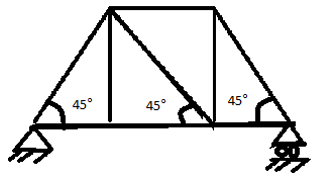
a) 8
b) 9
c) 10
d) 12
Explanation: The truss is supported by hinged support at one end and roller support at other end. Hinged support in a pin jointed plane frame does not offers any degree of freedom as rotation is not considered. But roller support offers horizontal movement and hence degree of freedom is 1. For the given truss, it consists of four pin joint offering two degree of freedom each. Therefore, the degree of freedom is 8 + 1 = 9.
5. Calculate the kinematic indeterminacy of the following pin jointed plane frame.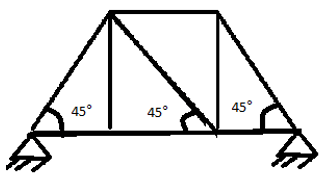
a) 8
b) 10
c) 12
d) 14
Explanation: The truss is supported by hinged support at both ends. Hinged support in a pin jointed plane frame does not offers any degree of freedom as rotation is not considered. For the given truss, it consists of four pin joint offering two degree of freedom each. Therefore, the degree of freedom is 8.
6. Calculate the kinematic indeterminacy of the following pin jointed plane frame.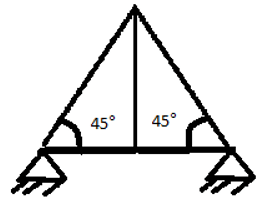
a) 4
b) 5
c) 6
d) 8
Explanation: The truss is supported by hinged support at both ends. Hinged support in a pin jointed plane frame does not offers any degree of freedom as rotation is not considered. For the given truss, it consists of two pin joint offering two degree of freedom each. Therefore, the degree of freedom is 4.
7. Top most part of an arch is called ________
a) Sofit
b) Crown
c) Center
d) Abutment
Explanation: Top most part is called crown. Other options are name of other part.
8. Which of the following is true in case of stone brick?
a) They are weak in compression and tension
b) They are good in compression and tension
c) They are weak in compression and good in tension
d) They are good in compression but weak in tension
Explanation: Stone brick is very good in compression but weak in tension.
9. Shape of three hinged arch is always :-
a) Hyperbolic
b) Circular
c) Parabolic
d) Can be any arbitrary curve
Explanation: Three hinged arch is always made in parabolic shape.
10. Internal bending moment generated in a three hinged arch is always:-
a) 0
b) Infinite
c) Varies
d) Non zero value but remains constant
Explanation: Due to its geometry, bending moment always comes out to be zero in 3 hinged arches